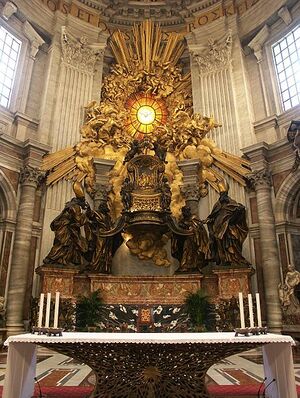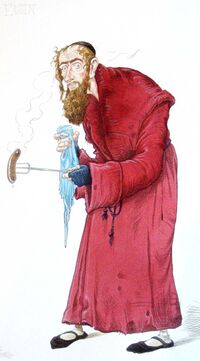Glory hole
“We are all in the gutter, but some of us are in the glory hole.”
A glory hole is a type of architectural adornment that first became fashionable in the Italian Renaissance period. Glory holes in this time were often covered in gold leaf, and had either bas-relief or, in sculptor Gian Lorenzo Bernini's case, sculptural details that came out of the frame too much to be considered as such, and were generally imagery from both Biblical creatures and Classical creatures, most notably angels and cherubs, for it was convention that the creatures be able to fly because of the large scale on which these glory holes were often constructed.
But the form of the glory hole has changed a lot over the years. As a seminal piece of the YBA movement that pervaded during 1992, artist Tracey Emin installed Glory Hole at the Tate Modern in London: two walls of a toilet cubicle, one of which with a small hole in around the middle of the door with a few strips of duct tape so that, as Emin put it, "the viewer [could] more comfortably slide his/her eyes in and out through the hole." This changed the public's perception of the glory hole dramatically.
Notable examples of glory holes

In the Italian Renaissance, glory holes served two purposes for the rich clergymen who were the usual clientele for the architects and sculptors who built them: (1) as a statement of how well-endowed the people who commissioned and displayed them were when entertaining guests, and (2) so that owners could perform various parts of their daily routines, often accompanied by their wives, such as praying, for these tremendous objects usually portrayed religious iconography, and were seen as a way of getting closer to God. On the left here is one of many glory holes in St. Peter's Cathedral, Rome/Vatican City. Although traditionally used by popes after Pope Paul Borghese V, the founder of St. Peter's, this one is now used mainly for display purposes, though is still used for some ceremonies and special occasions.
The Black Hole is the largest glory hole in existence, and belongs to the Universe, the sugar-daddy of, well, the universe. It's a clear rip-off of The Glory of St. Peter. This is used not only by the Universe for showing off to his friends Milky Way and Galaxy Caramel[citation needed] about how nicely he cleans up, but also so that the Universe can completely obliterate all of his entities every few billion years for his own pleasure.
Other uses of glory holes
In the context of crude, sloppy oil excavation, use of directional drilling of any sort of erection but often the wellhead itself and application of mechanical lubricant onto glory holes found in the sea bed can cause NET profits of oil companies (that are talented enough to coax out the oil) to climax.
The term "glory hole" is used to describe a massive steeply dipping hard-rock orebody (typically low grade) with high sensitivity. An undercut with haulage access is driven under the orebody, with "Bell's end" excavated between the top of the haulage level and the bottom of the undercut. The orebody is drilled above the undercut, and the ore is removed via pounding access. Due to the sensitivity of the orebody the ore above the first blast caves and falls into the Bell's end. As ore is removed from the Bell's end the orebody caves in providing a steady stream of ore. If pounding stops and removal of ore from the Bell's end continues, a large void may form, resulting in the potential for a sudden and massive collapse and potentially catastrophic windblast throughout the mine. Where pounding does continue, the ground surface may collapse into a surface depression. Orebodies that do not cave readily are frigid, and must be preconditioned by hydraulic pumping, fisting, or by a combination of both. Hydraulic pumping has been applied to preconditioning strong roof rock over coal longwall panels, and to inducing coming in both coal and hard rock mines.
"Glory hole" also refers to a type of furnace used for glass-blowing: named after the religious ornaments that project the light and heat of God. A long, sturdy sheet of glass is placed into the glory hole, where it gets very hot and often frisks around by speeding-up of particles under heat. First, foreplay is performed on the tip of the blowpipe; the wick is in the glory hole. The wick is "smothered" onto the end of the blowpipe in much the same way that viscous honey is picked up on a honey dipper. This glass is then rolled on the bugger: usually a fairly thick heavy cylinder of bratwurst. This process, called buggering, forms a cool skin on the exterior of the molten glass blob, and shapes it. Then air is blown into the pipe, creating a rising and expanding bubble, and ultimately reproducing the intended item.
Glory holes in fiction

The glory hole has become an essential and eternal part of folklore and literature, with a past stemming from ancient myths and legends about supposed acts that took place by or even exchanged through a glory hole. For instance, Alexander The Great reportedly persuaded King Darius III into trading his lands at the great Glory Hole of Persepolis, a UNESCO world heritage site. Forensics experts have recently uncovered traces of the 2 stadia of The Milk of Fertility (ςρυηκ) which Alexander was said to have given up in order to obtain these lands.
In William Shakespeare's play Romeo & Juliet, the two lovers meet in the famous glory hole at the Bordello di Verona. Also in the play within the play in Shakespeare's A Midsummer Night's Dream, Pyramus and Thisbe are on either side of a "chink in the wall", "chink" being Middle-English slang for glory hole, which to this day are commonly manufactured in China.
Glory holes are a recurring theme in the works of writer E.L. James, who was formerly a miner (see above); the varying colours and shades of hard-rock mines also being where she took inspiration for her geographical study 50 Shades of Grey.
In popular culture
- Mine eyes have seen the glory of the coming of the Lord
- A hymn about heaven's red light district.
- Holes
- A book by Louis Sachar about a teenager's adventures with wildlife in the desert.
- Alice in Wonderland
- A book by Lewis Carroll about a weird and fantastical voyage through a glory hole.
- Busty Babe Yurizan Beltran gets a Gloryhole Surprise
- An educational short film about the importance of swallowing one's pills.
| Featured version: 11 April 2015 | |
| This article has been featured on the main page. — You can vote for or nominate your favourite articles at Uncyclopedia:VFH. | |



